All that’s spicy and historical of cinnamon under one roof
The island’s first cinnamon museum (filling a major lacuna, as Sri Lanka alone gives the world the best and truest of this burnished spice) was opened at Mirissa Hills in Mirissa earlier this month. After traversing the rainforest-like property (dark and mist-shrouded), the cheery yellow-ochre-orange building beams in the early morning light, custom built to celebrate the spice that put Ceylon on the map.
Mirissa Hills is a working cinnamon estate, and had two lettable buildings – a grand walauwwa called the Bungalow and a stylish new house named Mount Cinnamon.
The new cinnamon museum, perched on a hillock below Mount Cinnamon, is built around a large central courtyard and its upper storey is dedicated to an elegantly curated display of everything cinnamon, admirably done in keeping with international standards.
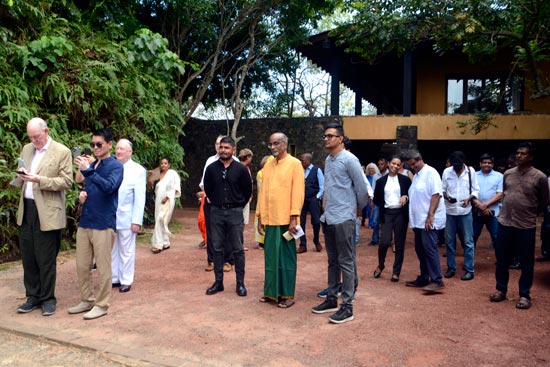
Guests at the soft opening of the museum on April 6. Pic by Priyanka Samaraweera
The project was conceived by advertising guru and Chairman of Mirissa Hills, Miles Young, who welcomed us with cinnamon rolls – ‘made especially by the German Bakery’ – and cinnamon tea, while Johann Peiris and the Ceylon Quartet serenaded the gathering on the verandah of Mount Cinnamon.
Later that morning the museum had its soft opening by Minister of Tourism Harin Fernando.
Mirissa Hills is architect C. Anjalendran’s Lunuganga (though owned by Miles). He originally designed the house with lake vistas and gardens that meander indoors and now the museum.
The Anjalendran touch is everywhere: a massive Laki Senanayake sculpture of a phoenix, the restful sofas in the corridors, the mellow but warm colours and the art including Ena de Silva batiks.
The museum is a sheer pleasure to explore. Climbing up the stairs you pass cinnamon maps from the days of Europe’s maritime quest for spices – the kind of quaint vintage maps where dragons breathe fire on the seas and grey prehistoric-looking pachyderms have two trunks.
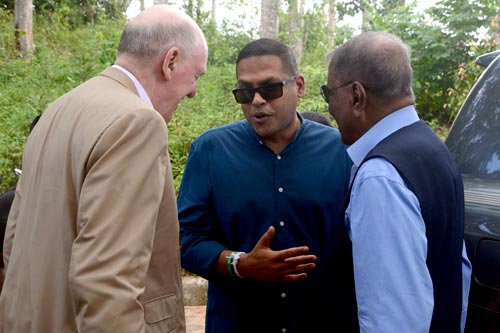
Mirissa Hills owner Miles Young with Tourism Minister Harin Fernando and veteran tea planter Herman Gunaratne
The main gallery shadowed by the central, hybrid phoenix, has the history of the condiment from Egyptian times when cinnamon was a ‘class marker’ for blue eye-shadowed ladies (and also for embalming mummies) down to the 15th Century when Columbus stumbled on the New World looking for India and the ‘Queen of spices’ and beyond.
The phoenix is tied with the legend of cinnamon because this bird is said to build its nest with cinnamon. Downstairs is a Chinese sculpture of a Cinnamologus, another mythical European medieval bird that also made its nest with cinnamon.
This visitors’ centre was curated by Young himself, while the design was by Byung Kim, of the Ashmolean Museum, Oxford. Half of it is dedicated to the mystic magic of cinnamon. There’s a poetry wall – where among the writings is Michael Ondaatje’s Cinnamon Peeler’s Wife.
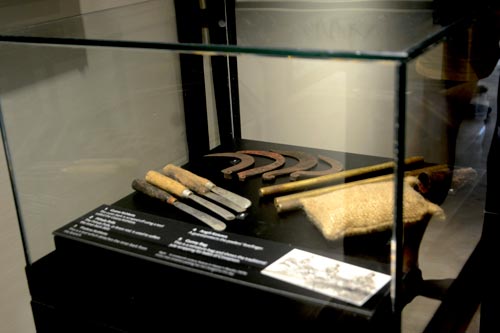
Tools of the trade: The cinnamon peeler's hook
Says Miles, “Cinnamon (has been)… associated with romance from Cleopatra to Barbara Cartland” (the Queen of Romance peppered her lavishly pink cookbook, Romance of Food with the spice).
Cinnamon is also associated with magic, both black and white. Says Miles referring to one haunting display “It is an extraordinary experience to go to a witch’s supermarket such as the vast one which exists in the Hamburg Docks, where cinnamon was imported, to see the various cinnamon products available for witches and warlocks.”
A section of the museum is dedicated to the true cinnamon’s role in its native land. It depicts how the traditional Salagama caste of peelers cultivated, lopped and prepared cinnamon, a wild plant till the Europeans came with their insatiable commerce. Indispensable to ayurveda medicine, the exhibits also highlight how cinnamon has been used since the time of King Ravana.
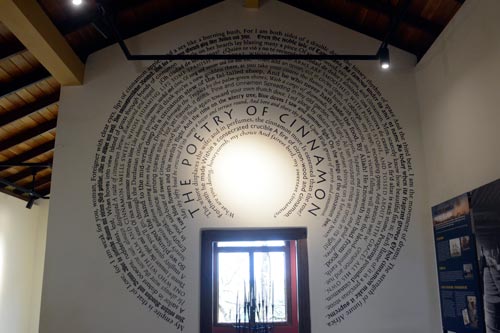
Poetry wall highlight: Michael Ondaatje’s Cinnamon Peeler’s Wife
The tour is fun, exciting and engaging, delving deep into how Rome or China liaised with cinnamon and fun facts like Princess Diana’s favourite dessert being poached pears with cinnamon ice cream – all illustrated beautifully.
There is a restaurant and a kitchen too with a rustic touch at the museum where you can indulge mostly in local southern cuisine but also some western favourites (including cinnamon ice cream).
The restaurant’s chairs have a roughhewn charm, and there are two massive tapestries on its walls; one a magnificent medieval French arras taken from a manuscript, depicting the Cinnamologus or ‘cinnamon bird’, the other a majestic Ena de Silva phoenix in hues of emerald and red burning in its orange nest fire.
For the visitor to the South, the museum offers some absorbing hours (depending on how thorough you are) of exploring the universe of Cinnamomum zeylanicum, probably the most iconic of all species- faunal or floral- native to our home land.
The museum is now open to the public from 9.30 a.m to 4.30 p.m. Admission costs Rs 4,500 per head.
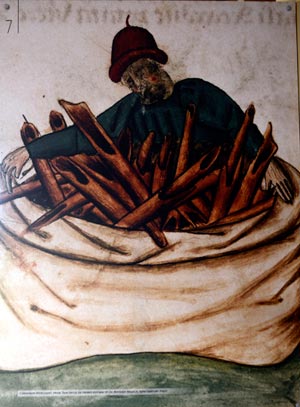
Painting depicting an ancient trade
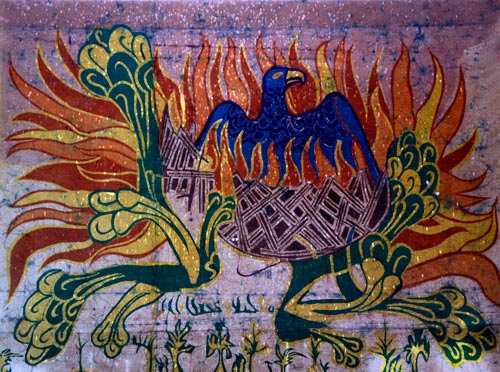
The phoenix batik by Ena de Silva
Searching for an ideal partner? Find your soul mate on Hitad.lk, Sri Lanka's favourite marriage proposals page. With Hitad.lk matrimonial advertisements you have access to thousands of ads from potential suitors who are looking for someone just like you.


